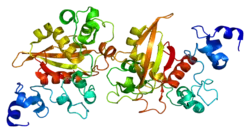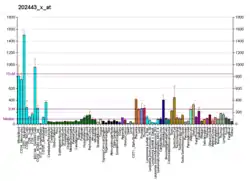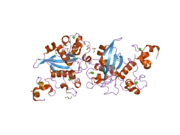Notch 2
Neurogenic locus notch homolog protein 2 (Notch 2) is a protein that in humans is encoded by the NOTCH2 gene.[5]
NOTCH2 is associated with Alagille syndrome[6] and Hajdu–Cheney syndrome.[7]
Function
Notch 2 is a member of the notch family. Members of this Type 1 transmembrane protein family share structural characteristics including an extracellular domain consisting of multiple epidermal growth factor-like (EGF) repeats, and an intracellular domain consisting of multiple, different domain types. Notch family members play a role in a variety of developmental processes by controlling cell fate decisions. The Notch signaling network is an evolutionarily conserved intercellular signaling pathway that regulates interactions between physically adjacent cells. In Drosophila, notch interaction with its cell-bound ligands (delta, serrate) establishes an intercellular signaling pathway that plays a key role in development. Homologues of the notch-ligands have also been identified in human, but precise interactions between these ligands and the human notch homologues remain to be determined. This protein is cleaved in the trans-Golgi network, and presented on the cell surface as a heterodimer. This protein functions as a receptor for membrane bound ligands, and may play a role in vascular, renal and hepatic development.[8]
Mutations within the last coding exon of Notch2 that remove the PEST domain and escape the nonsense-mediated mRNA decay have been shown to be the main cause of the Hajdu-Cheney syndrome.[9][10][11]
Interactions
NOTCH2 has been shown to interact with:
References
- GRCh38: Ensembl release 89: ENSG00000134250 - Ensembl, May 2017
- GRCm38: Ensembl release 89: ENSMUSG00000027878 - Ensembl, May 2017
- "Human PubMed Reference:". National Center for Biotechnology Information, U.S. National Library of Medicine.
- "Mouse PubMed Reference:". National Center for Biotechnology Information, U.S. National Library of Medicine.
- Larsson C, Lardelli M, White I, Lendahl U (May 1995). "The human NOTCH1, 2, and 3 genes are located at chromosome positions 9q34, 1p13-p11, and 19p13.2-p13.1 in regions of neoplasia-associated translocation". Genomics. 24 (2): 253–8. doi:10.1006/geno.1994.1613. PMID 7698746.
- Samejima H, Torii C, Kosaki R, Kurosawa K, Yoshihashi H, Muroya K, Okamoto N, Watanabe Y, Kosho T, Kubota M, Matsuda O, Goto M, Izumi K, Takahashi T, Kosaki K (2007). "Screening for Alagille syndrome mutations in the JAG1 and NOTCH2 genes using denaturing high-performance liquid chromatography". Genet. Test. 11 (3): 216–27. doi:10.1089/gte.2006.0519. PMID 17949281.
- Simpson MA, Irving MD, Asilmaz E, Gray MJ, Dafou D, Elmslie FV, Mansour S, Holder SE, Brain CE, Burton BK, Kim KH, Pauli RM, Aftimos S, Stewart H, Kim CA, Holder-Espinasse M, Robertson SP, Drake WM, Trembath RC (2011-03-06). "Mutations in NOTCH2 cause Hajdu-Cheney syndrome, a disorder of severe and progressive bone loss". Nature Genetics. 43 (4): 303–5. doi:10.1038/ng.779. PMID 21378985. S2CID 205357391.
- "Entrez Gene: NOTCH2 Notch homolog 2 (Drosophila)".
- Simpson MA, Irving MD, Asilmaz E, Gray MJ, Dafou D, Elmslie FV, Mansour S, Holder SE, et al. (2011). "Mutations in NOTCH2 cause Hajdu-Cheney syndrome, a disorder of severe and progressive bone loss". Nature Genetics. 43 (4): 303–305. doi:10.1038/ng.779. PMID 21378985. S2CID 205357391.
- Isidor B, Lindenbaum P, Pichon O, Bézieau S, Dina C, Jacquemont S, Martin-Coignard D, Thauvin-Robinet C, Le Merrer M, Mandel JL, David A, Faivre L, Cormier-Daire V, Redon R, Le Caignec C (2011). "Truncating mutations in the last exon of NOTCH2 cause a rare skeletal disorder with osteoporosis". Nature Genetics. 43 (4): 306–8. doi:10.1038/ng.778. PMID 21378989. S2CID 205357384.
- Majewski J, Schwartzentruber JA, Caqueret A, Patry L, Marcadier J, Fryns JP, Boycott KM, Ste-Marie LG, McKiernan FE, Marik I, Van Esch H, Michaud JL, Samuels ME (2011). "Mutations in NOTCH2 in families with Hajdu-Cheney syndrome". Hum Mutat. 32 (10): 1114–7. doi:10.1002/humu.21546. PMID 21681853. S2CID 39342783.
- Shimizu K, Chiba S, Saito T, Kumano K, Takahashi T, Hirai H (July 2001). "Manic fringe and lunatic fringe modify different sites of the Notch2 extracellular region, resulting in different signaling modulation". J. Biol. Chem. 276 (28): 25753–8. doi:10.1074/jbc.M103473200. PMID 11346656.
- Shimizu K, Chiba S, Hosoya N, Kumano K, Saito T, Kurokawa M, Kanda Y, Hamada Y, Hirai H (September 2000). "Binding of Delta1, Jagged1, and Jagged2 to Notch2 rapidly induces cleavage, nuclear translocation, and hyperphosphorylation of Notch2". Mol. Cell. Biol. 20 (18): 6913–22. doi:10.1128/mcb.20.18.6913-6922.2000. PMC 88767. PMID 10958687.
- Blaumueller CM, Qi H, Zagouras P, Artavanis-Tsakonas S (July 1997). "Intracellular cleavage of Notch leads to a heterodimeric receptor on the plasma membrane". Cell. 90 (2): 281–91. doi:10.1016/s0092-8674(00)80336-0. PMID 9244302. S2CID 16544864.
- Espinosa L, Inglés-Esteve J, Aguilera C, Bigas A (August 2003). "Phosphorylation by glycogen synthase kinase-3 beta down-regulates Notch activity, a link for Notch and Wnt pathways". J. Biol. Chem. 278 (34): 32227–35. doi:10.1074/jbc.M304001200. PMID 12794074.
- Shimizu K, Chiba S, Kumano K, Hosoya N, Takahashi T, Kanda Y, Hamada Y, Yazaki Y, Hirai H (November 1999). "Mouse jagged1 physically interacts with notch2 and other notch receptors. Assessment by quantitative methods". J. Biol. Chem. 274 (46): 32961–9. doi:10.1074/jbc.274.46.32961. PMID 10551863.
Further reading
- Artavanis-Tsakonas S, Rand MD, Lake RJ (1999). "Notch signaling: cell fate control and signal integration in development". Science. 284 (5415): 770–6. Bibcode:1999Sci...284..770A. doi:10.1126/science.284.5415.770. PMID 10221902. S2CID 16790253.
- Kojika S, Griffin JD (2001). "Notch receptors and hematopoiesis". Exp. Hematol. 29 (9): 1041–52. doi:10.1016/S0301-472X(01)00676-2. PMID 11532344.
- Schwarzmeier JD, Hubmann R, Düchler M, Jäger U, Shehata M (2005). "Regulation of CD23 expression by Notch2 in B-cell chronic lymphocytic leukemia". Leuk. Lymphoma. 46 (2): 157–65. doi:10.1080/10428190400010742. PMID 15621797. S2CID 36863790.
- Stifani S, Blaumueller CM, Redhead NJ, Hill RE, Artavanis-Tsakonas S (1993). "Human homologs of a Drosophila Enhancer of split gene product define a novel family of nuclear proteins". Nat. Genet. 2 (2): 119–27. doi:10.1038/ng1092-119. PMID 1303260. S2CID 32142845.
- Katsanis N, Fitzgibbon J, Fisher EM (1996). "Paralogy mapping: identification of a region in the human MHC triplicated onto human chromosomes 1 and 9 allows the prediction and isolation of novel PBX and NOTCH loci". Genomics. 35 (1): 101–8. doi:10.1006/geno.1996.0328. PMID 8661110.
- Hsieh JJ, Nofziger DE, Weinmaster G, Hayward SD (1997). "Epstein-Barr virus immortalization: Notch2 interacts with CBF1 and blocks differentiation". J. Virol. 71 (3): 1938–45. doi:10.1128/JVI.71.3.1938-1945.1997. PMC 191274. PMID 9032325.
- Blaumueller CM, Qi H, Zagouras P, Artavanis-Tsakonas S (1997). "Intracellular cleavage of Notch leads to a heterodimeric receptor on the plasma membrane". Cell. 90 (2): 281–91. doi:10.1016/S0092-8674(00)80336-0. PMID 9244302. S2CID 16544864.
- Bigas A, Martin DI, Milner LA (1998). "Notch1 and Notch2 inhibit myeloid differentiation in response to different cytokines". Mol. Cell. Biol. 18 (4): 2324–33. doi:10.1128/mcb.18.4.2324. PMC 121486. PMID 9528802.
- Berezovska O, Xia MQ, Hyman BT (1998). "Notch is expressed in adult brain, is coexpressed with presenilin-1, and is altered in Alzheimer disease". J. Neuropathol. Exp. Neurol. 57 (8): 738–45. doi:10.1097/00005072-199808000-00003. PMID 9720489.
- Gray GE, Mann RS, Mitsiadis E, Henrique D, Carcangiu ML, Banks A, Leiman J, Ward D, Ish-Horowitz D, Artavanis-Tsakonas S (1999). "Human ligands of the Notch receptor". Am. J. Pathol. 154 (3): 785–94. doi:10.1016/S0002-9440(10)65325-4. PMC 1866435. PMID 10079256.
- Shimizu K, Chiba S, Kumano K, Hosoya N, Takahashi T, Kanda Y, Hamada Y, Yazaki Y, Hirai H (2000). "Mouse jagged1 physically interacts with notch2 and other notch receptors. Assessment by quantitative methods". J. Biol. Chem. 274 (46): 32961–9. doi:10.1074/jbc.274.46.32961. PMID 10551863.
- Shimizu K, Chiba S, Hosoya N, Kumano K, Saito T, Kurokawa M, Kanda Y, Hamada Y, Hirai H (2000). "Binding of Delta1, Jagged1, and Jagged2 to Notch2 rapidly induces cleavage, nuclear translocation, and hyperphosphorylation of Notch2". Mol. Cell. Biol. 20 (18): 6913–22. doi:10.1128/MCB.20.18.6913-6922.2000. PMC 88767. PMID 10958687.
- Wu L, Aster JC, Blacklow SC, Lake R, Artavanis-Tsakonas S, Griffin JD (2001). "MAML1, a human homologue of Drosophila mastermind, is a transcriptional co-activator for NOTCH receptors". Nat. Genet. 26 (4): 484–9. doi:10.1038/82644. PMID 11101851. S2CID 23335042.
- Sriuranpong V, Borges MW, Ravi RK, Arnold DR, Nelkin BD, Baylin SB, Ball DW (2001). "Notch signaling induces cell cycle arrest in small cell lung cancer cells". Cancer Res. 61 (7): 3200–5. PMID 11306509.
- Shimizu K, Chiba S, Saito T, Kumano K, Takahashi T, Hirai H (2001). "Manic fringe and lunatic fringe modify different sites of the Notch2 extracellular region, resulting in different signaling modulation". J. Biol. Chem. 276 (28): 25753–8. doi:10.1074/jbc.M103473200. PMID 11346656.
- Saxena MT, Schroeter EH, Mumm JS, Kopan R (2001). "Murine notch homologs (N1-4) undergo presenilin-dependent proteolysis". J. Biol. Chem. 276 (43): 40268–73. doi:10.1074/jbc.M107234200. PMID 11518718.
- Inglés-Esteve J, Espinosa L, Milner LA, Caelles C, Bigas A (2002). "Phosphorylation of Ser2078 modulates the Notch2 function in 32D cell differentiation". J. Biol. Chem. 276 (48): 44873–80. doi:10.1074/jbc.M104703200. PMID 11577080.
External links
- GeneReviews/NCBI/UW/NIH entry on Alagille syndrome
- OMIM entries on Alagille syndrome
- Overview of all the structural information available in the PDB for UniProt: Q04721 (Neurogenic locus notch homolog protein 2) at the PDBe-KB.








